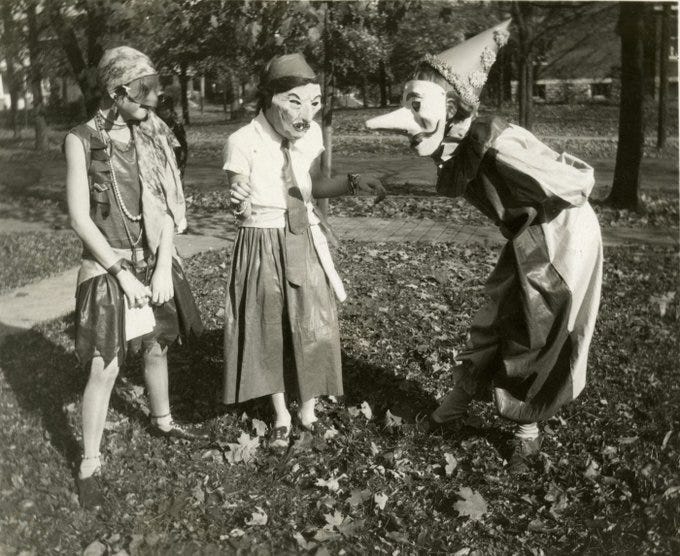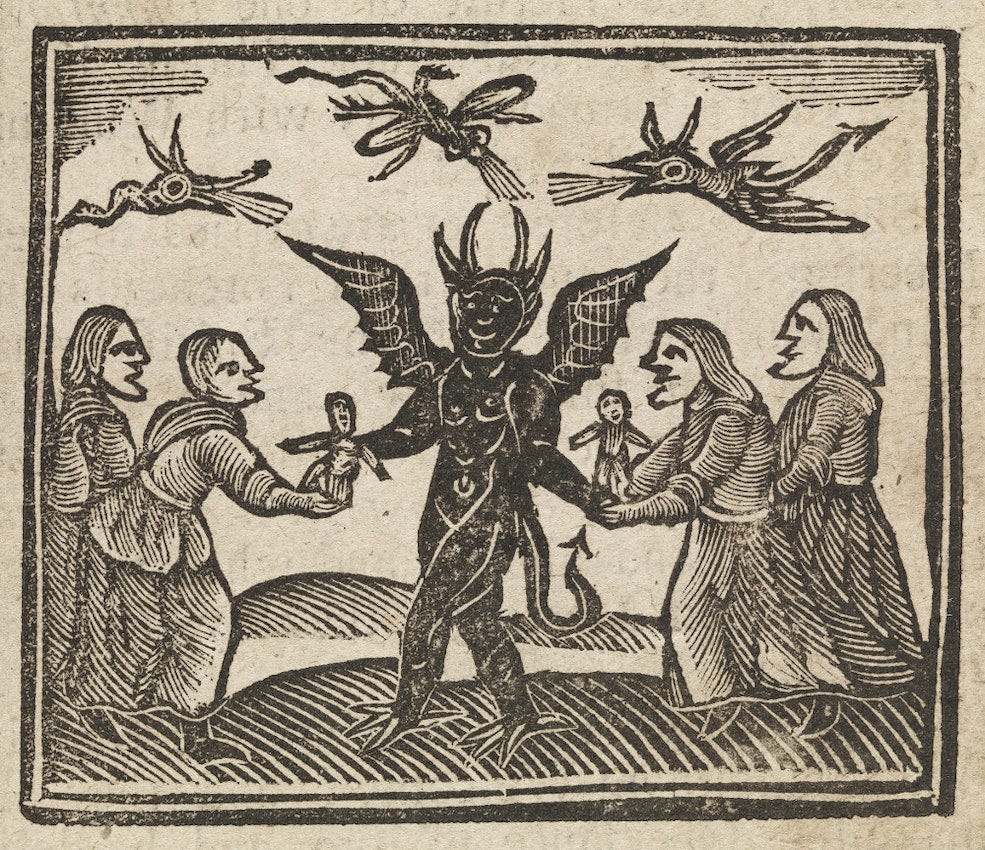image credit: Three girls posing in their masked costumes as they prepare for Halloween festivities in a photo from 1929; from Hammer Horror Films via TheMysticWood.
I’ve got a dirty secret… i came to my interest in paganism, magic, witchcraft, and the occult via Advanced Dungeons & Dragons, movies, tv shows, music, and pulpy paperback novels and “grimoires.” (Maybe those Christian fundamentalists were right to be concerned in the ‘80s, after all?) For some inexplicable reason, my soul screamed out for the magical, the ineffable, the Sublime at all costs - it still does. Even before i started coming across cultural representations of magic, i was certain it existed; i just had to find it.
Imagine my excitation when i came upon, in retrospect, a fairly newagey tome at my local library in Highland, In. called Black Magic, White Magic. I felt vindicated upon measure when i flipped through this slim occult tome, jammed full of arcane sigils, symbols, and diagrams. I was hooked.
Black Magic, White Magic may’ve been my entryway to the labyrinth but i’ve been following the whorls and swirls of its inward spiral for the last 30 years, like a stylus working its way towards the center. It’s informed nearly every decision i’ve made, ever since, but its been a rocky, tumultuous journey, full of false starts, dead ends, bad information, and plain bad decisions.
This was all happening in the late ‘80s and early ‘90s, well before the hyperlinked card catalog that is the internet. Finding good, quality information on esoteric matters was challenging, to say the least. Heck, it still is, and we have the world at our fingertips.
Suffice it to say, i made some very questionable decisions that i have since come to be at least deeply embarrassed by if not out-and-out regret. For much of my time as a practicing magician, i identified as an occultist, as many do, as i was dredging out a lot of my information and insights from the industrial underground of the ‘90s. For many years, i was an avowed Thelemite, which is one of the things i almost regret. I respect Aleister Crowley’s scholarship but have my doubts about him as a person, which makes it difficult to respect his body of work in toto. I would also take to Chaos Magic very strongly, as was so often the case among goths, ravers, and psychonauts in the ‘90s, sitting alone in my room and …ahem… charging my sigils.
It’s not that any of these things are regrettable in-and-of-themselves. It’s just a might embarrassing as it’s so cliche. At least i never got too into Laveyan Satanism.
Nevertheless, i persisted, following the signs and the augurs from my Gods and all the spirits to the best of my ability. I’m still following, to this very day…
As a result of this sporadic, disjointed, and self-directed, i’ve picked up some very questionable information along the way. My belief system and practice is intensely eclectic, as well, stitched together from belief systems and cosmologies from all over the world.
Which brings us to our main point…
On Postmodern Witchcraft
For those of us living in the West during the latter half of the 20th Century and the first two head-boilingly confusing decades of the 21st, postmodernism is the air that we breathe. It is inescapable, unavoidable. For those not familiar with that heady, loaded term, the gist is a deconstruction of Modernism, interrogating officials narratives as potential ideology and propaganda and questioning the value judgements around how we perceive culture, i.e. “high culture” v. “low culture.”
Postmodernism takes into account how we’re constantly taking in information from all over. How you might be reading Ovid’s Metamorphoses while listening to Taylor Swift’s Midnights while 80s infomercials play in the background.
Postmodernism, however, does not offer easy answers. It lends itself perhaps too easily to cynicism, to nihilism, and to the psychology of the neoliberal marketplace. Using our above example, someone could make the case that those infomercials are just as valid, just as culturally relevant, and just as worthwhile as the Metamorphoses. By some arguments, Midnights could be 10000x more relevant than both, combined, despite the fact its only been around for around 4 days while the other’s been around for around 2014 years. To say they’re the same would be disingenuous at best.
Which brings us to the double-edged athame of postmodern witchcraft, (which isn’t much of an official thing, which is part of why i’m writing this.) On one hand, this cultural flattening encourages thinking things are the same, that one can shop around for magic and spirituality like you would a dELiA*s catalog. This approach runs the risk of reducing Gods, spirits, and energy to a commodity to be collected and commodified, as pointed out so eloquently by my wonderful girlfriend and partner Melissa Sullivan.


While occult correspondences can be useful, especially for research, it’s important to not reduce Gods and spirits to their surface-level trappings. Yes, Hermes, Mercury, and Thoth are all Gods of scribes and communication. To say that Hermes is the same as Thoth, though, or even more ill-advisedly is Thoth (apart from maybe in the chimerical figure of Hermes Trismegistus) would be a mistake, and potentially a disastrous one depending on what you’re messing with.
The inverse of this would be the “let people enjoy things!” contingent on social media, suggesting that people’s beliefs aren’t hurting anybody, and that they should be above critique or reproach for some of their decisions.
Which is maybe also not the best.
Let’s be real, witchcraft has been having a moment for at least the last 10 years. It was practically mainstream during the time of American Horror Story Coven and peak Tumblr. During this time, it’s fair to say that a lot of people were exposed to witchcraft for the first time. How many were first introduced to witchcraft via trendy, chic Instagram posts? This is point 1 of this post - it’s important to not judge people for how they come to witchcraft.
This is point 1 of this post - it’s important to not judge people for how they come to witchcraft.
It’s important to remember that witchcraft is more than cute flat-brimmed hats and Rose Quartz vibrators, too, though. And when you encounter people engaging in this kind of spiritual commodification, it’s okay to perhaps gently pull them back a little bit.
The other main question raised by postmodernism is the question of cultural appropriation, which is an ongoing and, as usually, fiercely disputed topic on social media.
For those of us who are making it up as we go along, there are clear answers to these questions. I would suggest, the advice that i’m following, trying your utmost to research the lore you use in your practice.
For those who are already practicing witches, i might slightly suggest you exercise some grace and tact should you come across using some magical symbol or knowledge incorrectly, but i can’t - and wouldn’t - tell you what to do. Follow yr heart, but remember we were all young witches once.
Welcome To Witch Week!
For the next 5 days, we’re going to be publishing essays, reviews, art, and sundry media about witches and witchcraft. So stay locked, let me know anything you’d like to see mentioned or shouted out, or your thoughts on any of the pieces so far, by leaving a comment. And make sure to
and make sure to never miss any posts! Any help spreading the word would be much appreciated as well!
Want More Witchcraft?
Follow @for3stpunk on Twitter and Instagram, TikTok, Letterboxd, Goodreads, and drop by the Facebook page!
Liking Hauntology Now? Buy Us A Coffee!
and make sure to






Certainly far longer than 10 years; the first modern witchcraft movement in the US started in the 1960s; there have since been big revivals in the 1980s, 1990s, 2000s and beyond...social media has certainly made its spread far more pervasive but it blew up on the internet in the last 1990s too.